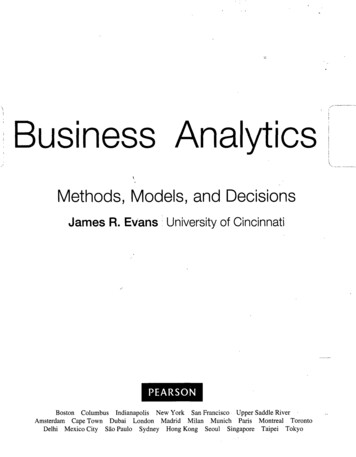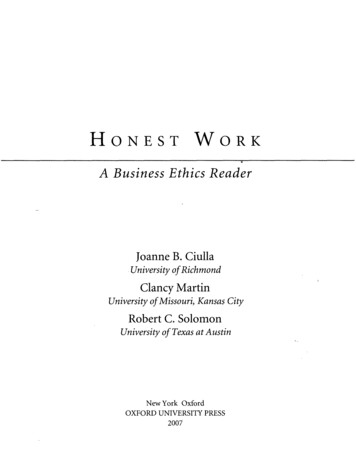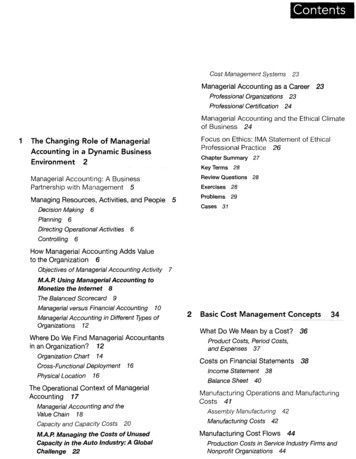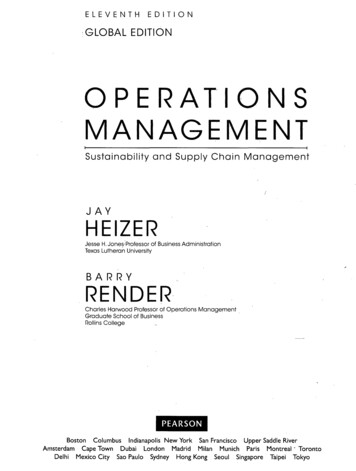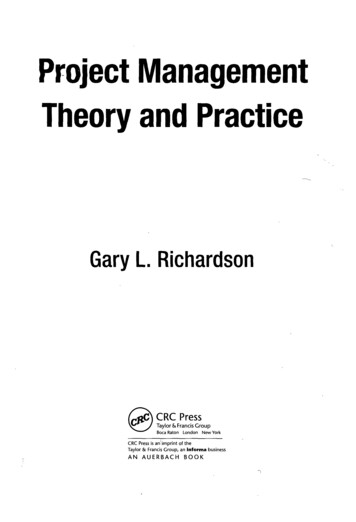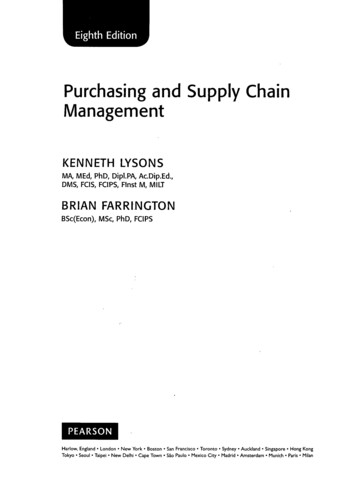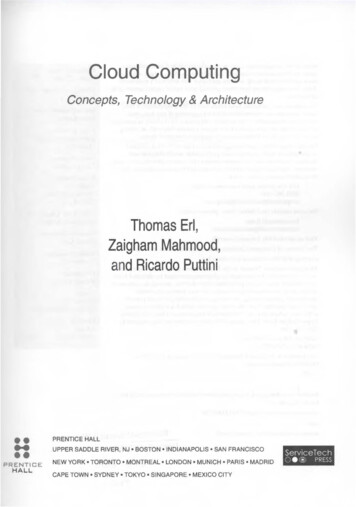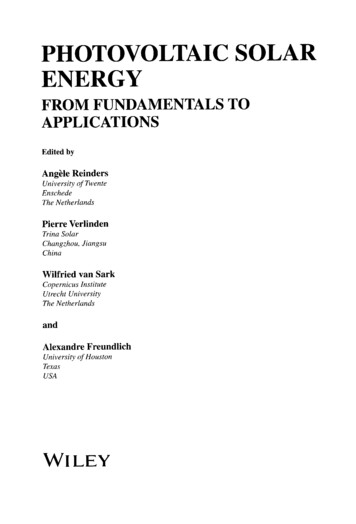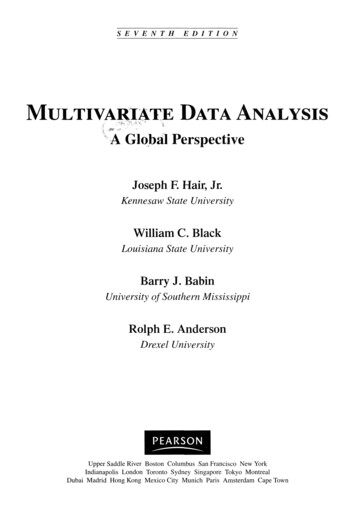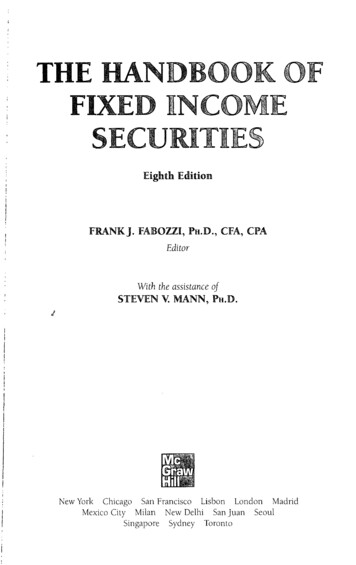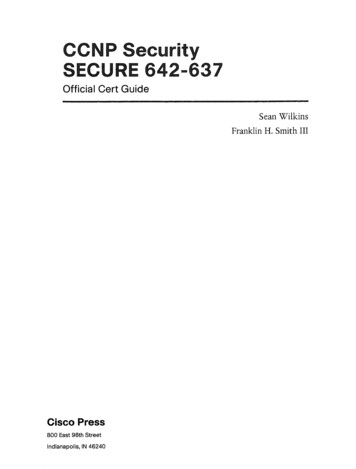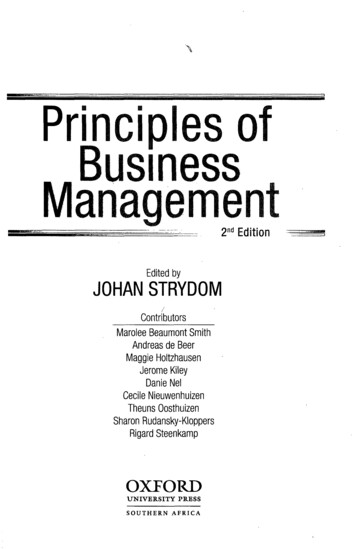
Transcription
Principles ofBusinessManagement2nd EditionEdited byJOHAN STRYDOMContributorsMarolee Beaumont SmithAndreas de BeerMaggie HoltzhausenJerome KileyDanie NelCecile NieuwenhuizenTheuns OosthuizenSharon Rudansky-KloppersRigard SteenkampOXFORDUNIVERSITY PRESSSOUTHERN AFRICA
Table of contentsPrefacei INTRODUCTION TO BUSINESSMANAGEMENTxxvPARTI Business and its challengesi3Johan StrydomPurpose of this chapter3Learning outcomes31.1 Introduction7.41.2 What is a business?41.2.1 Business and profits51.3 The economic principle61.4 The factors of production71.4.1 Natural resources71.4.2 Human resources81.4.3 Capital91.4.4 Entrepreneurship101.5 The economic systems in which businesses operate111.6 South African businesses and the changing social contract 121.6.1 The expectations of business-related stakeholders141.6.2 The expectations of opinion-related stakeholders151.6.3 The expectations of public-related stakeholders151.6.4 Corporate social responsibility161.6.5 The current social contract of a South African business . 171.7 The parts of this book19Case study: Shoprite 2010 annual report — how theShoprite group is interacting with its stakeholders21Summary23Glossary24Multiple-choice questions26References and end-notes27Answers to multiple-choice questions28
PRINCIPLES OF BUSINESS MANAGEMENT2 The business environment29Jerome KileyPurpose of this chapterLearning outcomes2.1 Introduction2.2 The systems approach2.3 The organisational environment2.3.1 The micro-environment2.3.2 The market environment2.3.3 The macro-environment2.3.3.1 The natural environment2.3.3.2 The technological environment2.3.3.3 The social environment2.3.3.4 The political environment2.3.3.5 The economic environment2.3.3.6 The international environment2.4 Conducting a SWOT analysis (study of the parts) of abusiness's environmentCase study: Pick n PaySummaryGlossaryMultiple-choice questions:References and end-notesAnswers to multiple-choice questionsPART2 MANAGEMENT TASKS3 The task of managementTheuns FJ OosthuizenPurpose of this chapterLearning outcomes3.1 Introduction3.2 What is management?3.3 What is a manager?3.4 Organisations in which managers work3.5 Levels of management3.5.1 Top management3.5.2 Middle management3.5.3 First-level 52535555555556565758595959
Table of contents\3.6 Management tasks3.6.1 Planning3.6.2 Organising3.6.3 Leading3.6.4 Motivating3.6.5 Controlling3.7 Areas of managements3.7.1 Production and operations managers3.7.2 Logistics managers3.7.3 Information-technology managers3.7.4 Financial managers3.7.5 Human-resources managers3.7.6 Marketing managers3.7.7 Public-relations managers3.7.8 Administrative managers3.8 Management skills3.8.1 Conceptual skills3.8.2 Human skills3.8.3 Technical skills3.9 Management competencies3.10 Management roles3.10.1 Decisional roles3.10.2 Interpersonal roles3.10.3 Informational rolesCase study: Toys for AfricaSummaryGlossaryMultiple-choice questionsReferences and end-notesAnswers to multiple-choice 656566666767686970717174747576Sharon Rudansky-KloppersPurpose of this chapterLearning outcomes4.1 Introduction4.2 Why planning is necessary4.3 The planning process4.3.1 Setting goals767676777779
PRINCIPLES OF B U S I N E S SfMANAGEMENTA4.3. i. i The mission statement of the organisation4.3.1.2 The environment of the organisation4.3.1.3 The values of management4.3.1.4 The experience of management4.3.2 A hierarchy of goals4.3.2.1 The mission statement4.3.2.2 The strategic goals4.3.2.3 The tactical goals4.3.2.4 The operational goals4.3.3 Criteria for setting effective goals4.3.4 Developing action plans4.3.4.1 Strategic plans4.3.4.2 Tactical plans4.3.4.3 Operational plans4.4 Implementing the selected plans4.5 The full circleCase study: Medical scheme takes actionSummaryGlossaryMultiple-choice questionsReferences and end-notesAnswers to multiple-choice questions5 929293Andreas de BeerPurpose of this chapterLearning outcomes5.1 Introduction5.2 The organising process5.2.1 Gathering information5.2.2 Identifying and analysing activities5.2.3 Classifying activities5.2.4 Allocating staff5.2.5 Assigning authority and responsibility5.2.6 Facilitating (encouraging) work5.3 Principles (basic rules) of organising5.3.1 Co-ordination5.3.1.1 The chain of command5.3.1.2 Unity of command9393939494949494959595959595
Table of contents5.3.1.3 Span of control965.3.2 Authority975.3.2.1 Line authority975.3.2.2 Staff authority.77975.3.2.3 Line-and-staff authority975.3.2.4 Functional authority975.3.2.5 Project authority975.3.3 Responsibility995.3.4 Accountability995.3.5 Delegation.,995.3.5.1 Centralisation and decentralisation1005.3.6 Specialisation1005.3.7 Divisionalisation1015.3.7.1 A divisional structure based on business functions1015.3.7.2 A divisional structure based on products1025.3.7.3 A divisional structure based on geographic location(place on the earth)1035.3.7.4 A divisional structure based on projects1035.3.7.5 A divisional structure based on consumer orclient needs1035.4 Organisational structures1065.4.1 The line organisational structure1065.4.2 The line-and-staff organisational structure1065.4.3 The functional organisational structure1075.4.4 The divisional organisational structure1085.4.5 The matrix organisational structure1085.4.6 The teams organisational structure1085.4.7 The network organisational structureno5.5 The changing organisationnoCase study:Jonny Happy Feet LimitedinSummary113Glossary113Multiple-choice questions114References and end-notes115Answers to multiple-choice questions1156 Leading116Maggie HoltzhausenPurpose of this chapter116
PRINCIPLES OF BUSINESS MANAGEMENTf:Learning outcomes6.1 Introduction6.2 The three components of leadership6.2.1 An interactive framework of leadership6.3 Leadership versus management6.4 A brief history of leadership theories6.4.1 Earlier leadership theories6.4.1.1 Trait theories6.4.1.2 Behaviour theories6.4.1.3 Situational approaches6.4.2 Newer leadership approaches6.4.2.1 A re-birth of earlier trait theories6.4.2.2 A move towards leadership-follower approaches6.4.2.3 Other leadership perspectives (theories)6.5 Leadership tools6.6 Leadership and diversity6.6.1 Leadership and gender6.6.2 Leadership and culture6.6.3 Integrating diverse leadership styles6.7 Worldwide leadership trendsCase study: Me, myself as manager and leaderSummaryGlossary'.Multiple-choice questionsReferences and end-notesAnswers to multiple-choice questions7 MotivatingJerome KileyPurpose of this chapterLearning outcomes7.1 Introduction7.2 What is motivation?7.3 The needs and expectations of employees7.3.1 Individual differences7.3.2 The needs of individuals7.3.2.1 Maslow's hierarchy of needs7.3.2.2 Alderfer's ERG Theory7.3.2.3 McClelland's Needs 38138139139140141
Table of contents7.3.3 The expectations of employees7.3.3.1 Expectancy Theory7.3.3.2 Equity Theory7.4 Managing employee's motivation7.4.1 Directly influencing employee behaviour7.4.1.1 Goal-setting Theory7.4.1.2 Behavioural modification (change)7.4.2 Facilitating (helping to bring about) employees'good performance7.4.2.1 The quality-of-work-life approach7.4.2.2 Herzberg's Two-Factor Theory7.4.2.3 The job characteristics model7.2.4.2 McGregor's Theory X and Theory Y, and the selffulfilling prophecy7.5 Monitoring employee morale7.6 Practical motivational strategiesCase study: SA's top employers as voted for by studentsSummaryGlossaryMultiple-choice questionsReferences and end-notes:Answers to multiple-choice questions8 ControllingTheuns FJ OosthuizenPurpose of this chapterLearning outcomes8.1 Introduction8.2 Types of control8.2.1 Pre-control8.2.2 Concurrent control8.2.3 Post-control8.3 Sources of control8.3.1 Individual self-control8.3.2 Group control8.3.3 Organisational control8.3.4 Stakeholder control8.4 The control process8.4.1 Developing performance 64164164164165
PRINCIPLES OF B U S I N E S SMANAGEMENT8.4.2 Measuring actual performance8.4.3 Comparing actual performance with performancestandards8.4.4 Reinforcing good performance, and correcting ifnecessary8.5 When to use a control measure8.6 Financial controls8.7 Quality controls;8.7.1 Total quality management8.7.2 Quality circles8.7.3 Six Sigma8.7.4 Benchmarking8.7.5 Continuous improvement8.7.6 Reduced cycle time8.8 The balanced scorecard8.9 The benefits of controllingCase study: Environmental management controls at Africangiant hotel and entertainment group -African SkiesSummaryGlossaryMultiple-choice questionsReferences and end-notesAnswers to multiple-choice questions3 THE FUNCTIONAL AREAS 1171172174174176177178PART9 Operations management179181Rigard SteenkampPurpose of this chapterLearning outcomes9.1 Introduction9.2 A brief history of operations management9.3 Operations management is the core function of anyorganisation9.4 Effectiveness, efficiency, and productivity9.5 Operations strategies9.6 Product design and operations design9.7 Operations planning and control181181182182183183185186189
Table of contents9.7.1 Reconciling (dealing with opposites) supply anddemand (give and take)9.7.1.1 Loading9.7.1.2 Sequencing9.7.1.3 Scheduling9.7.1.4 Monitoring9.7.1.5 Addressing bottlenecks9.7.2 Demand management9.7.3 Fixed-capacity planning9.7.4 Adapting capacity to a change in demand.;9.7.5 Inventory management9.7.6 Material-requirements planning9.7.7 Make-or-buy decisions9.7.8 Operation improvement9.7.8.1 Quality and quality management9.7.8.2 Statistical process control9.7.8.3 Maintenance and replacement9.7.8.4 Safety, health and environmental management9.8 Project planning and control9.8.1 Project planning and Gantt charts9.8.2 Network analysisCase study:The lean paradigm at L'OrealSummaryGlossaryMultiple-choice questionsReferences and end-notesAnswers to multiple-choice questions10 Logistics managementDanie NelPurpose of this chapterLearning outcomes10.1 Introduction10.2 Defining logistics management10.3 The objectives of logistics management10.3.1 Minimising total logistics costs10.3.2 Increasing customer service10.3.3 Trade-offs between minimising costs andoptimising 213213214214
PRINCIPLES OF B U S I N E S SMANAGEMENT10.4'Activities of logistics10.4.1 Purchasing management10.4.2 Order processing10.4.3 Inventory management10.4.4 Transportation10.4.5 Warehousing10.4.6 Materials-handling and packaging10.5 Integrated logistics10.6 Reverse logistics10.7 Global logistics. Case study: Using distribution centres to improvecustomer serviceSummaryGlossaryMultiple-choice questionsReferences and end-notesAnswers to multiple-choice questions11 Financial managementMarolee Beaumont SmithPurpose of this chapterLearning outcomes11.1 Introduction.11.2 The functions of financial management11.2.1 Analysing the financial position of a business11.2.2 Managing the assets of a business11.2.3 Managing the liabilities (what is to be paid) of abusiness11.3 The core principles of financial management11.3.1 The cost-benefit principle11.3.2 The risk-return principle11.3.3 The time-value-of-money principle11.4 Analysing financial statements11.4.1 The balance sheet11.4.2 The income statement11.5 Ratio analysis11.5.1 Liquidity ratios11.5.1.1 The current ratio11.5.1.2 The quick 2243243244
VTable of contents11.5.2 Asset-management ratios11.5.2.2 Inventory turnover11.5.2.3 Average collection period11.5.2.4 Total asset turnover24424424524511.5.3 D e b t - m a n a g e m e n t ratios11.5.3.1 T h e debt ratio24624611.5.3.2 T h e gearing ratio11.5.3.3 T h e interest-coverage ratio11.5.4 Profitability ratios11.5.4.1 T h e gross profit margin11.5.4.2 T h e profit margin11.5.4.3 T h e return o n total assets11.5.4.4 T h e return o n equity.,24724724724824824824911.5.5 Applying ratio analysis11.6 Break-even analysis11.6.1 Fixed and variable costs11.6.2 T h e break-even point11.6.3 Some limitations of break-even analysis11.7 Financing capital requirements11.7.1 S h o r t - t e r mfinancingn.7.1.1 Trade credit11.7.1.2 Bank credit24924925025125325425425425511.7.1.3 Factoring of trade receivables25611.7.2 L o n g - t e r m financing11.7.2.1 Equity funding'.11.7.2.2 L o n g - t e r m b a n k loans11.7.2.3 Financial leasesn . 8 T h e cash budget11.8.1 Preparing a cash budget11.9 Managing trade receivables and inventories11.9.1 Managing trade receivables256257257257258260260260n.9.1.1 Credit policy11.9.1.2 Credit terms26126111.9.1.3 Collection policy11.9.2 M a n a g i n g inventories11.9.2.1 T h e o p t i m u m level of inventory holdingsCase study: Financial ratio analysis of Polokwane PrintingCompanySummary261263263264266
JPRINCIPLES OF BUSINESS M A N A G E M E N TrGlossaryMultiple-choice questionsReferences and end-notesAnswers to multiple-choice questions12 Human-resources managementMaggie HoltzhausenPurpose of this chapterLearning outcomes12.1 Introduction12.2 The role of human-resources management12.3 The human-resources management process12.3.1 Strategic human-resources planning12.3.1.1 Job analysis12.3.1.2 Human-resources forecasting12.3.2 Staffing the organisation12.3.2.1 Recruitment12.3.2.2 Selection12.3.2.3 Induction12.3.3 Developing and assessing the organisation's humanresources12.3.3.1 Training and development12.3.3.2 Performance management12.4 Maintaining the organisation's human resources12.5 Important trends in human-resource managementCase study: Oyster Bay LodgeSummaryGlossaryMultiple-choice questionsReferences and end-notesAnswers to multiple-choice questions13 Marketing managementSharon Rudansky-Klopp
PRINCIPLES OF BUSINESS MANAGEMENT 8.4.2 Measuring actual performance 166 8.4.3 Comparing actual performance with performance standards 166 8.4.4 Reinforcing good performance, and correcting if necessary 167 8.5 When to use a control measure 167 8.6 Financial controls 169 8.7 Quality controls; 169 8.7.1 Total quality management 169 8.7.2 Quality circles 170 8.7.3 Six Sigma 170 8.7.4 .
